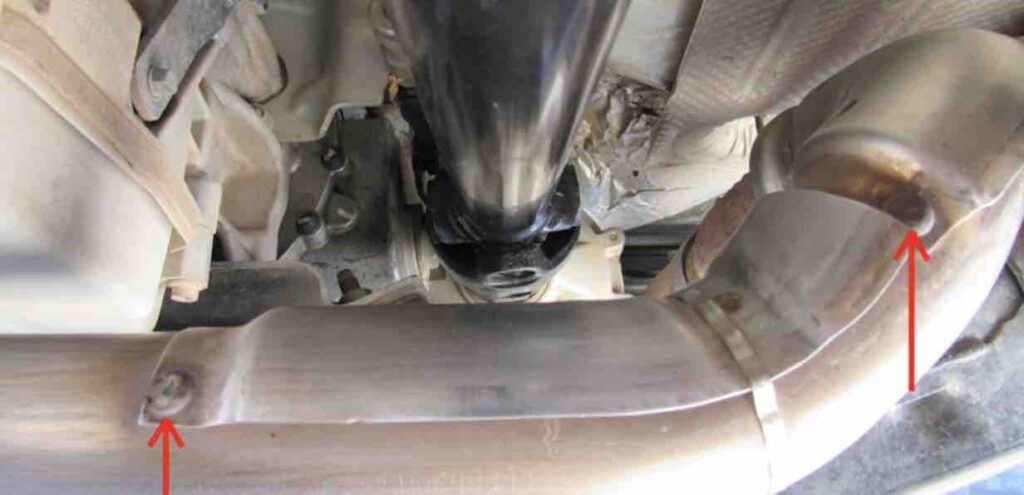Last updated on July 12th, 2023 at 09:39 am
Having a faulty catalytic converter is detrimental to the overall performance of your vehicle. Before the catalytic converter’s eventual breakdown, a few signs and symptoms are likely to pop up. These symptoms are not hard to miss because the diminished performance of your car will become more apparent.
Procrastinating on a damaged catalytic converter is not a good idea. Acting on these symptoms as swiftly as possible will save you the trouble of dealing with more issues that might stack up on your engine. In this article, we will be laying out the various symptoms that your catalytic converter is either damaged or overheating.
Continue reading to discover all you need to know about the various signs of having a damaged or overheated catalytic converter.
How To Diagnose A Bad Catalytic Converter
Testing or diagnosing your catalytic converter will give you a good idea of the extent of its damage. With this information, you will be able to decide better if a repair or replacement is to be made.
Follow the steps below to complete the full diagnosis of your catalytic converter.
- First, you will need to remove the catalytic converter’s mounting hardware from the exhaust manifold.
- With the last step completed, the passage of gases will become much easier. However, if no improvement is made to your engine, move on to the next step.
- Carry out a back pressure test. This test will help you diagnose if your exhaust system is clogged.
- During this test, you will need to pay special attention to plugged pipes or mufflers.
- During this test, essential tools like the back pressure gauge are indispensable.
- A temperature test is also necessary for the overall diagnosis process. For this, you will need an infrared thermometer.
With these diagnosis steps completed, you should have a good grasp on the condition of your catalytic converter. As regards the final test, If your catalytic converter is operating properly, its rear should have a 20-degree temperature difference from its front.
Signs Of A Bad Catalytic Converter & Overheated Catalytic Converter Symptoms
General Signs Of A Bad Catalytic Converter
In this section, we will address the symptoms you will need to look out for when you have a bad catalytic converter, and some of these symptoms may also present themselves as a sign of Overheated Catalytic Converter Symptoms.
1. Engine stalling
Your engine is more likely to stall when starting if the exhaust system is clogged. The car engine will receive excessive fuel that it cannot burn if the catalytic converter is clogged.
This will in turn, lead to back pressure, making the engine work harder to expel the exhaust gases. In conditions like this, your car will start and runs for 2 to 3 seconds, and then stops. To solve this problem, you will need to clear up your exhaust.
2. Rumbling noises
When a piece of the honeycomb material inside the catalytic converter comes apart, it makes rattling noises. This is a result of too much heat or minor harm that has built up over time while idling or driving.
You will need to fix your catalytic converter quickly to resolve the problem. Because fragments of the honeycomb material will travel deeper through the exhaust system and into the muffler if they are not attended to.
3. Check Engine Light
The ‘Check Engine Light’ will come on if the catalytic converter is malfunctioning or damaged. The efficiency of the catalytic converter is measured by oxygen sensors.
These sensors monitor the gas levels in your vehicle’s exhaust system. Because the ‘Check Engine Light’ could represent several different things, all you need to do is park your car and check your engine when it comes on.
4. Foul smell
A catalytic converter will give off a foul or rotten eggs smell when it gets damaged. This is mainly caused by a small amount of sulfur being present in your gasoline. Therefore, when the gasoline burns, the sulfur turns into hydrogen sulfide.
When the catalytic converter is working properly, the pungent sulfur dioxide is transformed into odorless sulfur dioxide by it. However, when it malfunctions, the conversion does not occur. This allows the unpleasant hydrogen sulfide to escape through your exhaust.
Overheated Catalytic Converter Symptoms
Additionally, other signs you may notice for overheated catalytic converters may include:
1. Increase in car exhaust temperature:
When the catalytic converter becomes overheated, it can cause an increase in exhaust temperature.
2. Rotten egg smell:
A damaged and overheated catalytic converter may, in some cases, produce a sulfurous odor similar to the smell of rotten eggs, some are on the lookout for this.
4. Decrease in fuel efficiency:
The restriction of exhaust flow caused by a damaged catalytic converter can also decrease fuel efficiency, which may, in other words, cause your cat to overheat.
What Happens When The Catalytic Converter Goes Bad?
When the catalytic converter malfunctions, your exhaust system will be unable to convert harmful emissions into cleaner gases. Additionally, a damaged catalytic converter will make it difficult for your engine to produce the pressure it needs to run.
Your engine won’t be able to “breathe” because the catalytic converter is essentially “choked” by an accumulation of carbon particles. You will also eventually experience a decrease in power and acceleration as a result of this. The final and most severe signs of a full breakdown are jerky motions and complete stall outs if exhaust flow.
Can A Catalytic Converter Be Repaired?
This depends on how severely damaged your catalytic converter is. If it cannot be saved, your only option will be to have it replaced. A repair will only be feasible if the cumulative damage isn’t over the top.
For instance, if sections of the honeycomb in your catalytic converter break off, any form of repair will not be feasible. Contrary to popular online opinions, replacement is your only choice in such situations.
How To Protect Your Catalytic Converter
With proper care, you will be able to increase the lifespan and efficiency of your catalytic converter. Follow the steps in this section to protect your catalytic converter.
- To maintain optimal combustion of the air-fuel mixture, you will have to regularly replace outdated or worn-out spark plugs.
- Carry out regular maintenance on the various components that make up your ignition system.
- Clean up your cylinders and valves regularly with a catalytic converter cleaner to prevent carbon buildup.
- Keep your cylinder gasket well maintained to prevent oil or coolant leaks in your vehicle combustion chamber.
- To prevent unburned fuel from entering your catalytic converter, don’t drive your car when your cylinder is misfiring.
Conclusion
Having a good knowledge of what to look out for when your catalytic converter is damaged will help you mitigate issues before they get too serious. Carrying out regular checkups, repairs, and maintenance will help keep your car in good shape. With the concepts we have covered in this article, you should be able to take care of your vehicle.
Related Article:
- How Can I Get the Best Price for My Catalytic Converter Scrap?
- Catalytic Converter Heat Shield Rattle fix
- Free Catalytic Converter Price Guide(Scrap Worth/ Price List)
- Are Catalytic Converters Worth More As Scrap Or When Functional In A Vehicle?
Reference:
- https://cartreatments.com/catalytic-converter-symptoms-and-replacement-cost/
- https://mechanicbase.com/engine/bad-catalytic-converter-symptoms/
- https://www.fiix.io/car-advice/articles/4-signs-of-a-failing-catalytic-converter
- https://axleaddict.com/auto-repair/How-to-Test-a-Bad-Catalytic-Converter
- https://dannysengineportal.com/catalytic-converter-knowing-the-basics-and-testing/
- https://thepalmbeachgarage.com/catalytic-converter/

Uchenna is a Radiographer and Auto parts mechanic who recently got his automotive diploma as an auto repair technician, and since then, has worked on fixing various car problems.
Working as just a radiographer, Uchenna didn’t just get all the fulfillment he desired, because he truly loved doing things tilted toward cars. As a kid, he would take apart his toy cars to see how they worked and would spend hours tinkering with his bike.
So, in 2017 he made the tough decision to become an auto mechanic. He threw himself into his studies and now loves every aspect of what he does.
He gets to work with his hands, solving problems and bringing cars back to life, and sharing his knowledge and easy quick-fix guide online are all part of what makes him feel fulfilled.


